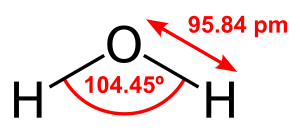The following technical article is kindly contributed by Pete Farmer, as a background for further practical considerations regarding water in extreme environments and medical preparedness.
* * *
“When the well is dry, we know the worth of water.” Benjamin Franklin, Poor Richard’s Almanac, 1746
Life and health cannot be sustained without water. Therefore, it should be of paramount importance to anyone doing disaster-preparedness planning. Before getting to the specifics of that problem, let us consider water itself for a moment, for it is, in many ways, a chemical miracle.
Water covers roughly 70% of the Earth’s surface; 97% of the world’s free water is found in its oceans; lakes, rivers, sub-surface aquifers, glaciers and the polar ice caps hold most of the rest. A small percentage of the total water supply is found in precipitation or gaseous/vaporous form (clouds, mist, steam, etc.) and in the Earth’s flora and fauna.
Chemically, water is unique – it is arguably nature’s most versatile and essential compound. Chemical formula H2O, each water molecule is composed of two hydrogen atoms and one oxygen atom, joined by covalently-bonded electrons. The oxygen atom carries a slight negative charge (is more electronegative) while the two hydrogen atoms carry a slight positive charge (are less electronegative). Such a molecule is referred to as polar, and possesses a “dipole moment,” i.e., it has an asymmetric distribution of electric charge across it. At standard temperature and pressure, water is a liquid. In pure form, water is odorless, tasteless and colorless, and does not conduct electricity (Important note: water is rarely pure in nature, and usually contains solutes such as dissolved salts; under these conditions water is a very effective conductor of electric current. Take appropriate precautions with electricity and water; they are almost always justified).
Water has surface tension, caused by dipole forces and hydrogen bonding between individual H2O molecules, which allows water to adhere it itself and other surfaces. Surface tension is responsible for capillary action, which allows water to move through circulatory capillaries and inside plants. Water exists in its different physical states – solid (ice), liquid, gas (steam or vapor) – and constantly cycles through them in nature. Uniquely, water is less dense as a crystalline solid – ice – than as liquid water, allowing ice to float. In liquid form, water is relatively incompressible, and conducts sound and kinetic energy efficiently. Left undisturbed, large bodies of H2O will stratify into temperature and pressure gradients. Water is an excellent temperature moderator in natural systems.
Water has a pH of 7, which is precisely neutral between acidic (pH < 7.0) and basic (pH > 7.0). The water molecule can donate a hydrogen ion (H+) or a hydroxide ion (OH-), but for most purposes, H2O is considered pH neutral. Water is often called the “universal solvent,” because – while not highly caustic – it is an excellent and highly-versatile dissolver, especially for polar and ionic compounds. Many non-polar (electrically neutral) organic compounds, including most fats and oils, are mutually insoluble (incapable of dissolving one another) and/or immiscible (incapable of being mixed to form a homogeneous substance) with water. Some hydroxyl-group-containing (OH-) organic compounds, i.e., many alcohols, are highly soluble in water because of the tendency of their OH- groups to form hydrogen bonds with water. Less-dense oils, fats and lipids tend to form a uniform film or layer atop water. Under specific conditions (not covered here), water and oil can mix in colloidal form.
Water highly-concentrated in salts, such as sea water, provides greater buoyancy than fresh water, and displays freezing-point depression and boiling point elevation. That is, salt-containing water will freeze below its normal freezing point (32o Fahrenheit / 0 o Celsius) and boil above its typical boiling point (212o Fahrenheit / 100 o Celsius) at standard temperature and pressure (STP, i.e., 32o Fahrenheit / 0 o Celsius temperature and atmospheric pressure of 760mm Hg/Mercury or 14.7 lb/square inch). At higher altitude, water boils at a lower temperature, other conditions constant. Water’s density is 1 gram per cubic centimeter (cc) or milliliter (ml) at 32.9 degrees F. It’s weight is approximately 62.4 lbs./cubic foot at 32 degrees F, or 8.33 lbs. per gallon.
The high latent heat of vaporization of water (the energy required to cause water to change state from liquid to gas) allows excellent evaporative cooling properties. Water has a relatively high specific heat (the heat required to raise the temperature of one gram of a substance one degree centigrade), and both stores and conducts heat energy well.
High purity water can be produced in a laboratory environment, by processes including distillation (boiling water and then collecting the condensed vapor in a very clean container, leaving behind solid contaminants), double-distilling (distillation x 2), deionization (demineralization/removal of positively or negatively-charged ions), filtration and microfiltration (passage of the water through a small or very small-pore-size filter capable of capturing microorganisms and/or chemical compounds and elements).
Other processes include reverse osmosis, carbon filtration, ultrafiltration, ultraviolet oxidation, and electrodialysis. Ultra-pure water for use in drug manufacturing or other sensitive applications may also be subject to autoclaving, i.e., high-pressure and temperature steam treatment, to kill suspected micro-organisms. The American Chemical Society and other sanctioning bodies have developed detailed standards for classifying various degrees of purity of water; interested parties may view these on the internet.
The above concludes our brief survey of the chemical and physical properties of water. Thus prepared, in the next installment, we will consider some practical specifics of water and survival in daily life, extreme environments, and in medical preparedness.
Copyright 2011 Peter Farmer
Related articles
- “Quantum Water” Discovered in Carbon Nanotubes (technologyreview.com)





